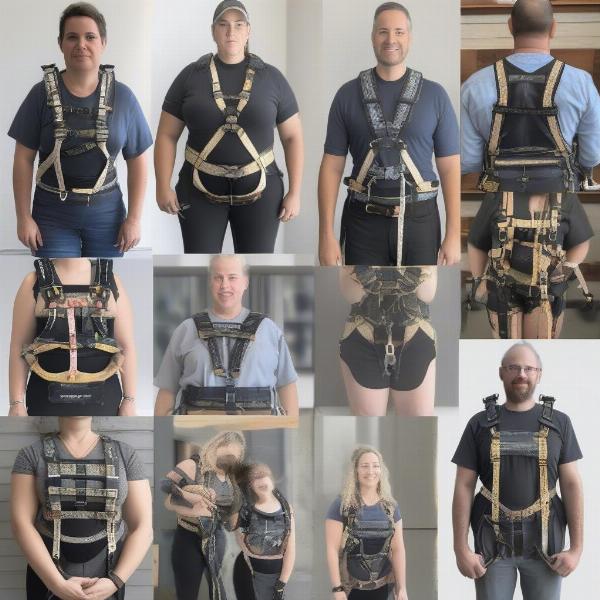A dog weight pulling harness is a crucial piece of equipment for any dog engaging in the sport of weight pulling. It’s more than just a harness; it’s a tool designed to distribute weight evenly, protect your dog from injury, and maximize their pulling power. Whether your dog is a seasoned competitor or just starting out, selecting the right harness is essential for their safety and success. This guide will delve into the key factors to consider when choosing a dog weight pulling harness, ensuring you find the perfect fit for your canine athlete.
Understanding the Importance of a Proper Dog Weight Pulling Harness
A well-fitted weight pulling harness allows your dog to utilize their strength effectively while minimizing strain on their body. It distributes the force of the pull across their chest and shoulders, reducing the risk of injury to their neck, back, and limbs. Unlike regular harnesses designed for walks, a weight pulling harness is built to withstand significant force and provide optimal comfort and support during pulling activities. Choosing the wrong harness can lead to discomfort, chafing, restricted movement, and potentially serious injuries.
Key Features to Consider When Choosing a Dog Weight Pulling Harness
 Various types of dog weight pulling harnesses.
Various types of dog weight pulling harnesses.
Several factors influence the selection of an appropriate dog weight pulling harness. Consider the following:
- Material: Look for durable, weather-resistant materials like nylon or leather. weight pulling harness for dogs are typically made of heavy-duty materials to withstand the strain of pulling.
- Fit: The harness should fit snugly but not restrict movement. It should allow your dog to breathe freely and maintain a natural gait. A poorly fitting harness can cause chafing and discomfort.
- Design: There are various designs available, including X-back, H-back, and straight harnesses. Each design distributes weight differently and is suited for different dog breeds and pulling styles. Consider your dog’s build and pulling technique when selecting a design.
- Padding: Adequate padding in key areas like the chest and shoulders is crucial for comfort and to prevent chafing. Look for harnesses with breathable padding to keep your dog cool during exertion.
- Adjustability: A harness with adjustable straps allows for a customized fit and ensures the harness stays secure during pulling.
Sizing Your Dog for a Weight Pulling Harness
Proper sizing is crucial for comfort and safety. Follow these steps to measure your dog:
- Girth: Measure around the deepest part of your dog’s chest, just behind their front legs.
- Neck: Measure around the base of their neck where a collar would sit.
- Back Length: Measure from the base of their neck to the base of their tail.
Consult the manufacturer’s sizing chart and use these measurements to select the appropriate size. If your dog is between sizes, it’s generally recommended to choose the larger size.
Getting Started with Weight Pulling
Once you’ve chosen the right anxious dog harness, it’s important to introduce your dog to weight pulling gradually. Start with light weights and short distances, gradually increasing the weight and distance as your dog builds strength and stamina.
“Proper training and conditioning are essential for any dog participating in weight pulling,” says Dr. Emily Carter, DVM. “Start slow and gradually increase the weight to avoid injury.”
Remember to always supervise your dog during weight pulling activities and ensure they have access to fresh water. If you notice any signs of discomfort or distress, stop the activity and consult with a veterinarian.
Conclusion
Choosing the right dog weight pulling harness is paramount for your dog’s safety, comfort, and performance in the sport. By considering factors like material, fit, design, padding, and adjustability, you can ensure your dog has the proper equipment to thrive. Remember to introduce weight pulling gradually, prioritize your dog’s well-being, and always consult with a veterinarian if you have any concerns. A suitable dog weight pulling harness is an investment in your dog’s health and enjoyment of this demanding yet rewarding activity.
FAQ
- What is the best material for a dog weight pulling harness? Durable and weather-resistant materials like nylon and leather are recommended.
- How do I know if my dog’s harness fits correctly? It should be snug but not restrictive, allowing free movement and breathing.
- What are the different types of weight pulling harness designs? Common designs include X-back, H-back, and straight harnesses.
- How do I introduce my dog to weight pulling? Start with light weights and short distances, gradually increasing as your dog builds strength.
- What should I do if my dog shows signs of discomfort during weight pulling? Stop the activity immediately and consult with a veterinarian.
- Where can I find a high-quality weight pulling harness for my dog? Check specialized pet stores or online retailers offering senior dog harness.
- Are there any specific breed recommendations for weight pulling? While many breeds can participate, some breeds like Alaskan Malamutes and Siberian Huskies are naturally predisposed to pulling.
About ILM Dog
ILM Dog is your trusted international resource for expert dog care advice. We cover a wide range of topics, from breed selection and health care to training, nutrition, grooming, and finding the perfect dog rope leashes. Whether you’re a new dog owner or a seasoned expert, we provide practical, up-to-date information to help you give your dog the best possible care. For any questions or inquiries, contact us at [email protected] or +44 20-3965-8624. We’re here to help you and your canine companion thrive!